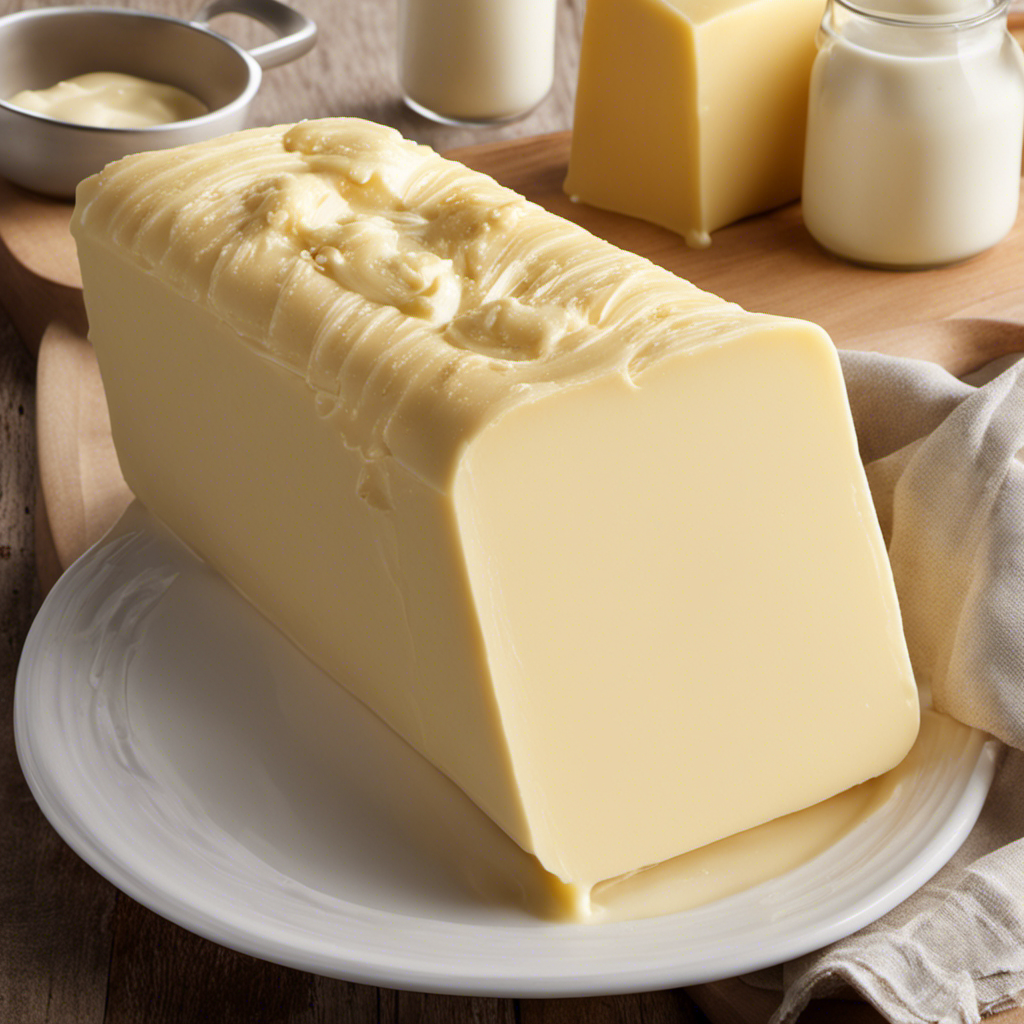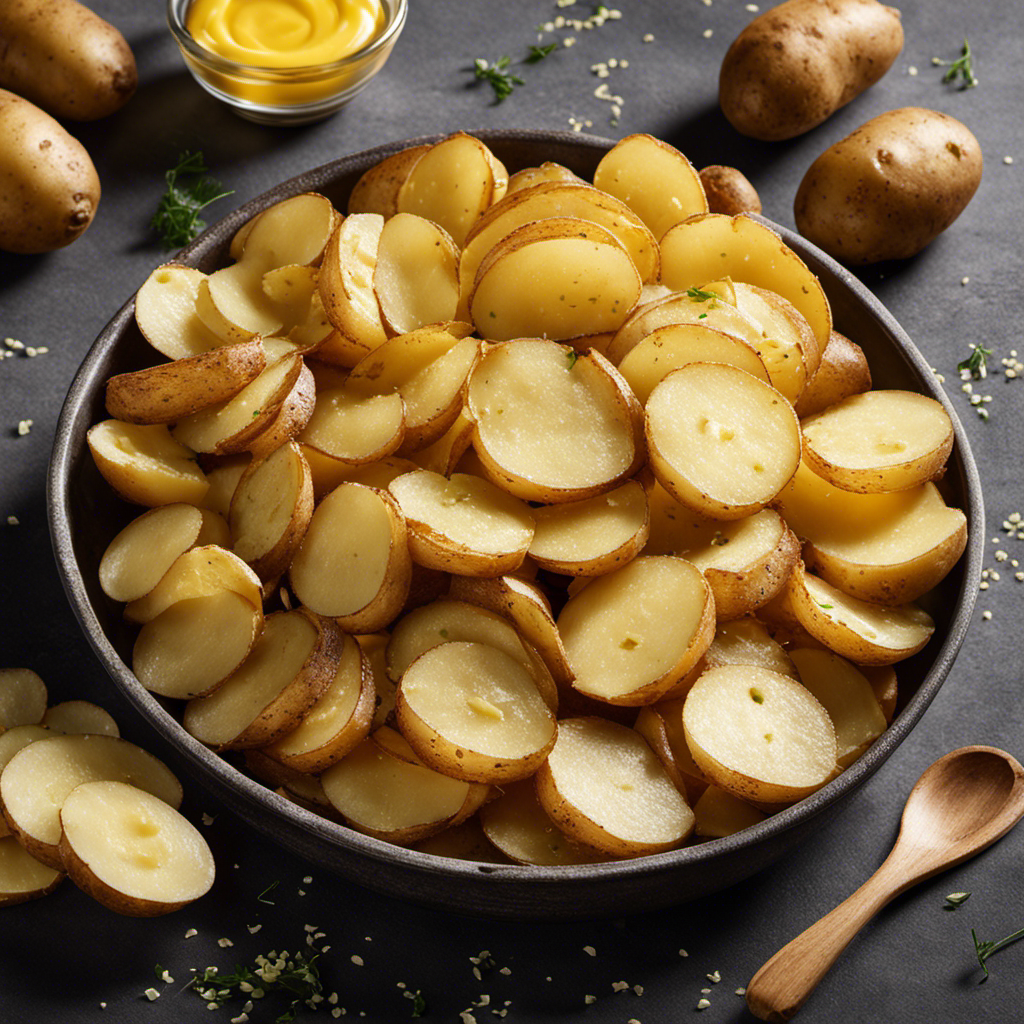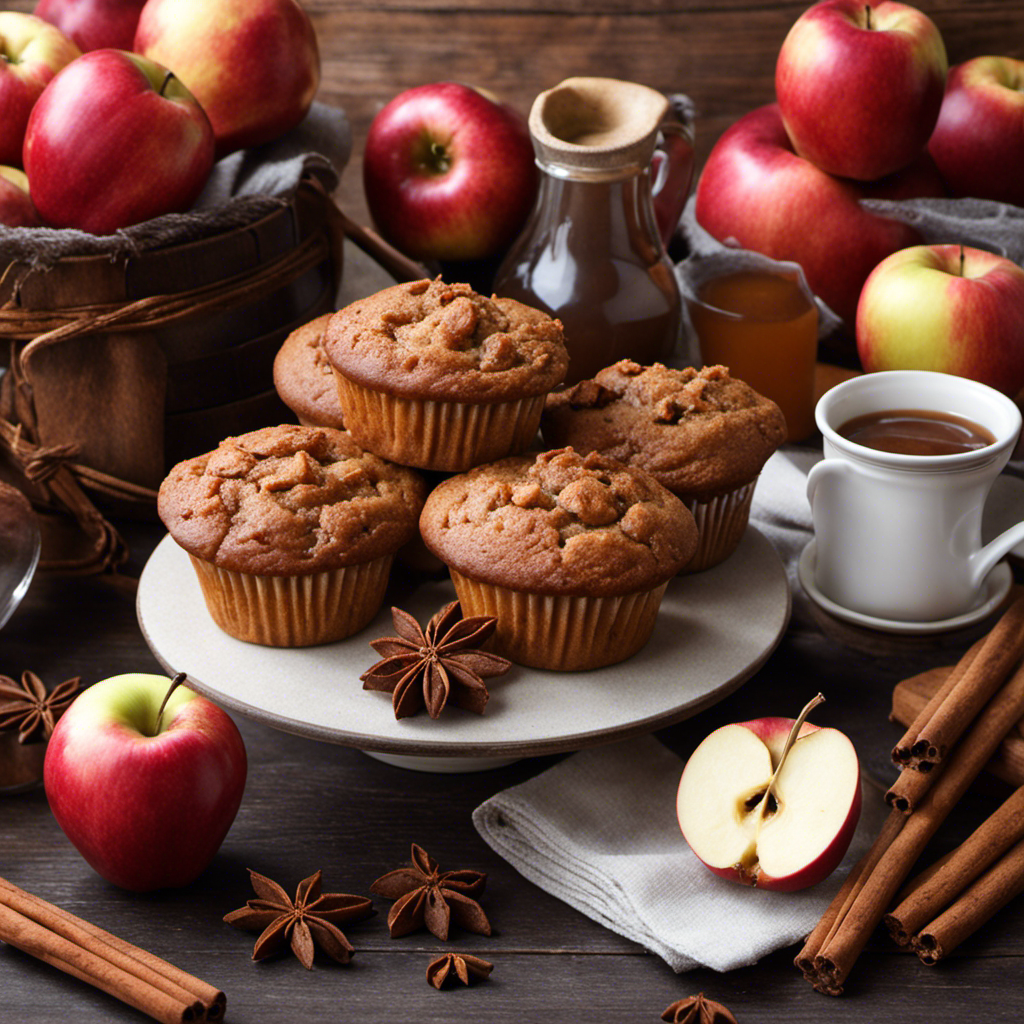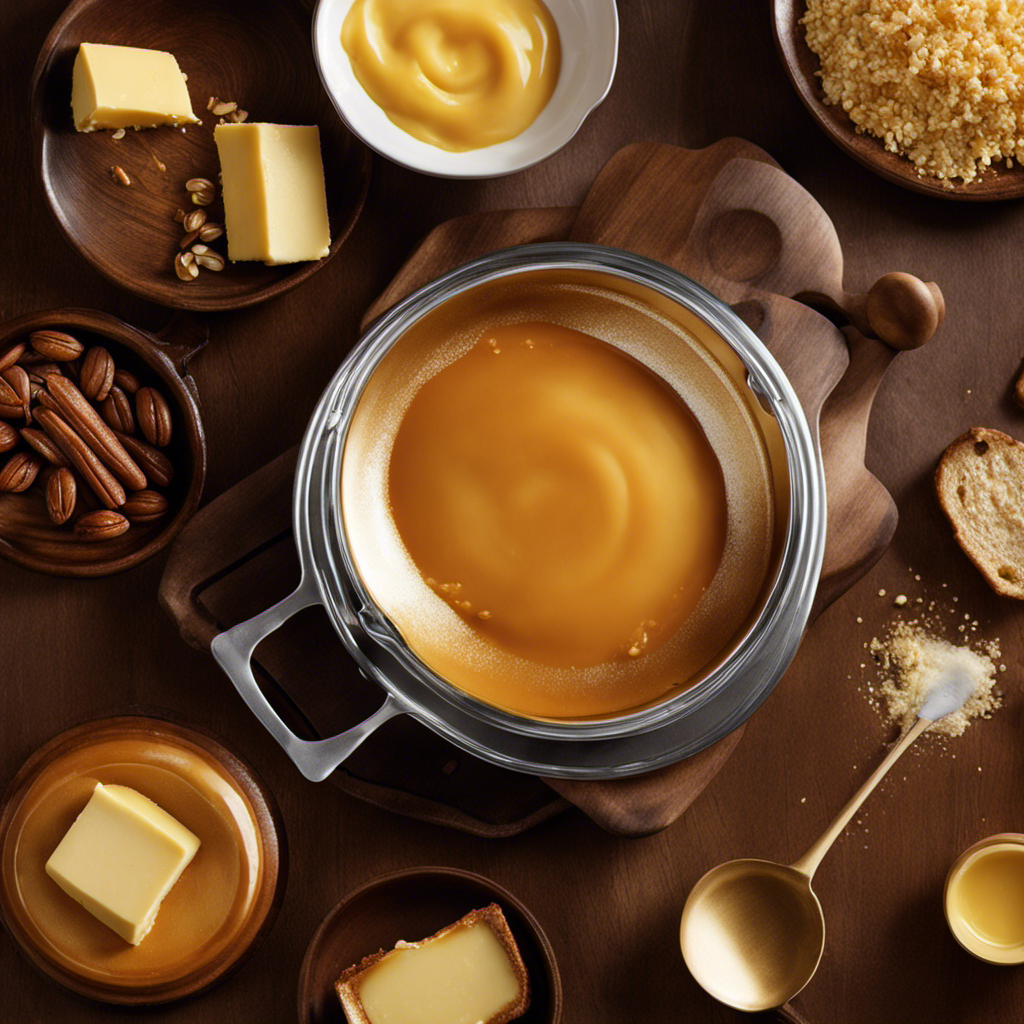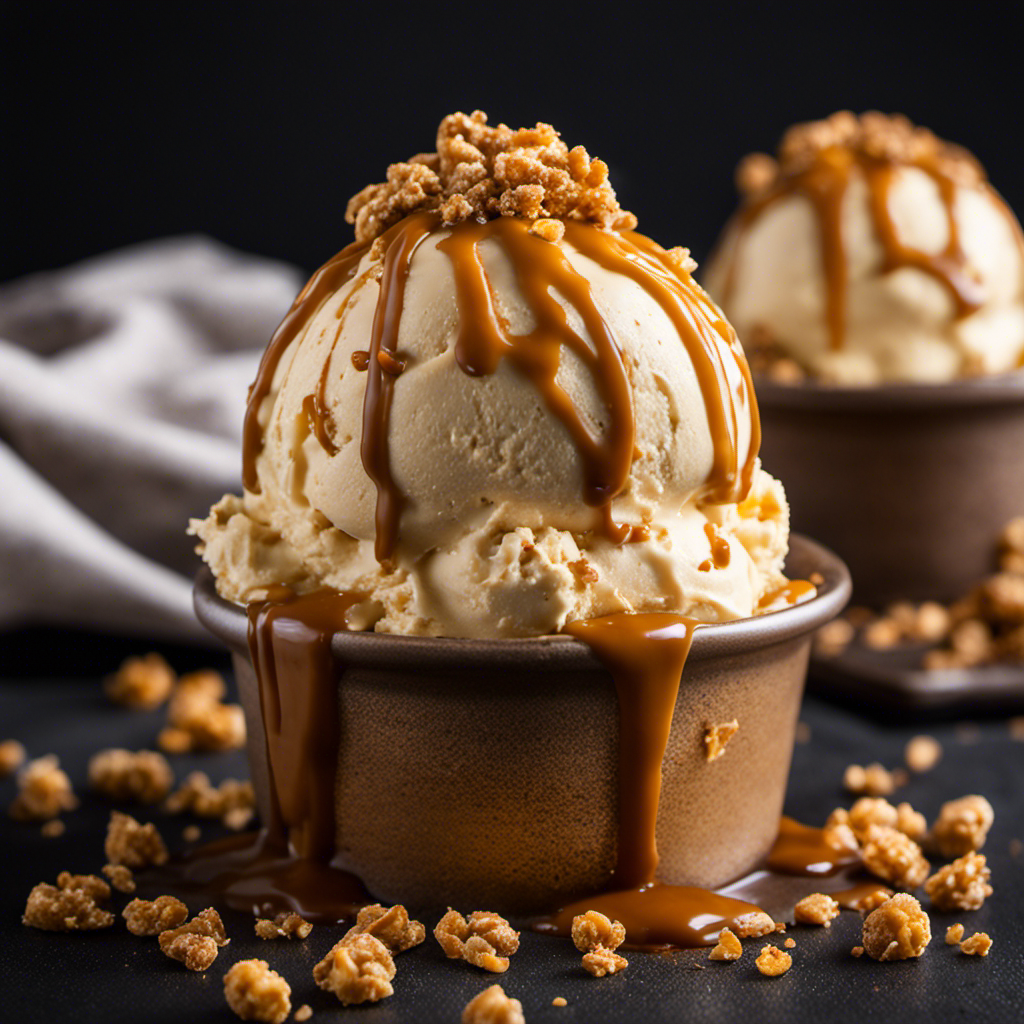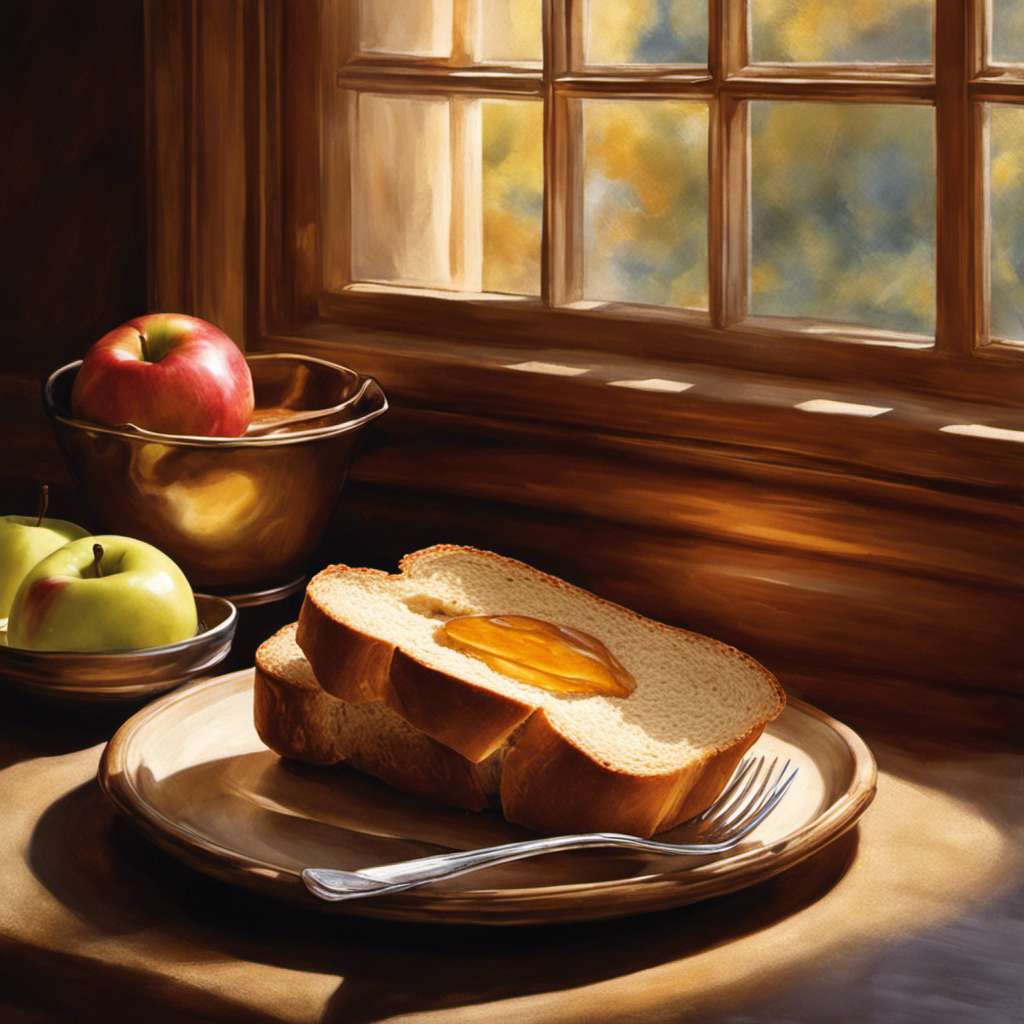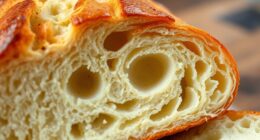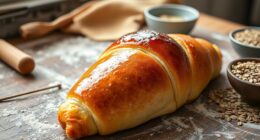Have you ever wondered about the factors that create the rich and delicious flavor of butter? Like a velvety cloud melting in your mouth, butter is truly a culinary wonder.
In this article, we will explore the precise ingredients that go into creating this delectable treat. From the history of butter-making to the process of separating cream from milk, we will delve into the scientific aspects of this kitchen staple.
Get ready to uncover the secrets behind the mouthwatering allure of butter.
Key Takeaways
- Butter is made by churning cream, which involves separating the fat globules from the liquid.
- Different types of butterfat and churning techniques influence the taste and quality of butter.
- Butter contains milk fat, water, protein, and milk solids, and is a rich source of fat-soluble vitamins and conjugated linoleic acid (CLA).
- Butter should be consumed in moderation due to its high fat content, but can add flavor, richness, and moisture to dishes.
History of Butter
The history of butter dates back thousands of years. Butter consumption has been a significant part of various cultures throughout history. In ancient civilizations, butter was not only consumed as a source of nutrition but also held cultural significance.
It was used in religious rituals and ceremonies, symbolizing purity and prosperity. The process of making butter was a labor-intensive task, requiring the separation of cream from milk and churning it until it transformed into a solid form.
Over time, advancements in technology and agriculture allowed for increased production and availability of butter. As societies evolved, butter became a staple in cooking and baking, adding flavor and texture to dishes.
Today, butter continues to be enjoyed worldwide, both for its nutritional value and cultural importance.
Butter Making Process
To make butter, you’ll need to start by churning cream. The cream separation process is a crucial step in butter making. By separating the cream from milk, you isolate the fat content necessary for butter production.
Churning is the mechanical process used to agitate the cream, causing the fat globules to come together and eventually form butter. This process requires a churn, which can be a simple hand-held device or a more advanced electric churn. The churning process typically takes around 20 minutes, but can vary depending on the cream’s fat content and temperature.
Once the butter has formed, it needs to be washed and kneaded to remove excess buttermilk and improve its texture. This can be done by placing the butter in a bowl of cold water and manually working it until the water runs clear.
Milk as the Main Ingredient
In this discussion, we will explore the debate between dairy and plant-based milk and their respective nutritional values.
You’ll learn about the key points surrounding this topic, including the composition of dairy milk and the nutritional benefits it offers.
Additionally, we’ll delve into the nutritional value of plant-based milk alternatives and how they compare to traditional dairy milk.
Dairy or Plant-Based
Butter can be made from either dairy or plant-based ingredients. While traditional butter is made from cow’s milk, there are now various dairy alternatives available. These alternatives are not only suitable for those with lactose intolerance or dairy allergies but also offer unique health benefits.
Here are some key points to consider:
- Dairy alternatives include soy, almond, coconut, and cashew milk.
- Soy milk is a popular choice due to its high protein content.
- Almond milk is low in calories and a good source of vitamin E.
- Coconut milk is rich in healthy fats and can boost heart health.
- Cashew milk is creamy and provides essential minerals like zinc and magnesium.
These plant-based alternatives provide a range of options for individuals looking to enjoy the taste and texture of butter while incorporating health benefits into their diet.
Nutritional Value of Milk
There’s a wide range of nutritional value in different types of milk. Milk is a complex mixture of proteins, carbohydrates, fats, vitamins, and minerals. It is a rich source of essential nutrients, including calcium, vitamin D, and potassium. These nutritional benefits make milk an important part of a balanced diet.
However, for individuals with lactose intolerance, consuming milk can be a challenge. Lactose intolerance occurs when the body is unable to digest lactose, the sugar found in milk. This can lead to digestive discomfort and other symptoms. Fortunately, there are lactose-free milk options available that provide the same nutritional benefits without the lactose.
Now, let’s explore another interesting aspect of milk: cream separation.
Cream Separation
In order to understand the churning process of butter, it is important to grasp the concept of cream separation.
Cream separation is the initial step in butter production. During this step, the milk is allowed to stand and the fat rises to the top, forming a layer of cream.
This cream is then subjected to churning, a mechanical process that agitates the fat globules until they coalesce and separate from the liquid. This results in the formation of butter.
It is worth noting that the butterfat content in butter can vary depending on factors such as the breed of the cow, the animal’s diet, and the processing techniques employed.
Churning Process Explained
During the churning process, cream is transformed into butter through the agitation of the fat molecules. This process involves the following steps:
- Temperature control: Maintaining a specific temperature is crucial for successful churning.
- Agitation: The cream is vigorously agitated, causing the fat globules to collide and clump together.
- Coalescence: As the fat globules collide, they merge to form larger fat particles.
- Separation: The fat particles start to separate from the liquid portion of the cream, known as buttermilk.
- Formation of butter: Continued churning causes the fat particles to solidify, resulting in the formation of butter.
Different types of butterfat can be used in the churning process, such as sweet cream butterfat or cultured cream butterfat. Each type imparts unique flavors and characteristics to the final product. The churning techniques and the choice of butterfat greatly influence the taste, texture, and quality of the butter produced.
Butterfat Content Variations
To achieve different variations in butterfat content, you can adjust the type and amount of cream used in the churning process. Butterfat density refers to the concentration of butterfat in the final product and can be influenced by the cream’s composition. The butterfat composition is determined by the breed of cow, its diet, and the processing methods applied to the cream.
Cream with higher fat content will result in butter with a higher butterfat density. Conversely, using cream with lower fat content will yield butter with a lower butterfat density. By carefully selecting and adjusting the cream used in churning, you can control the butterfat content to create different textures and flavors in your butter.
This leads us to the next topic: salted vs unsalted butter.
Salted Vs Unsalted Butter
Salted butter contains added salt, while unsalted butter does not. The presence or absence of salt in butter can significantly impact its taste and usage. Let’s explore the benefits of salted butter and why unsalted butter is preferred for baking:
- Salted butter benefits:
- Enhances flavor: The addition of salt in butter enhances its natural taste, making it more savory and appealing.
- Longer shelf life: The salt acts as a preservative, extending the shelf life of salted butter.
- Versatile usage: Salted butter is perfect for spreading on bread, melting over vegetables, or adding richness to cooked dishes.
- Convenience: The seasoning in salted butter eliminates the need for additional salt during cooking or baking.
- Balanced flavor: The salt content in salted butter provides a well-rounded flavor profile in recipes.
However, when it comes to baking, unsalted butter is preferred. Its neutral taste allows for better control of the salt content in the recipe, ensuring the desired flavor balance.
Moving on to the nutritional value of butter…
Nutritional Value of Butter
The nutritional value of butter can vary depending on factors such as the cow’s diet and the production process. Butter is primarily composed of milk fat, but it also contains small amounts of water, protein, and milk solids.
It is a rich source of fat-soluble vitamins like vitamin A, E, and K. Butter is also a good source of conjugated linoleic acid (CLA), a type of fatty acid that has been linked to various health benefits, including reduced risk of heart disease and improved immune function.
Additionally, butter contains saturated fats and cholesterol, which should be consumed in moderation. In cooking, butter adds flavor, richness, and moisture to dishes. It is commonly used in baking, sautéing, and as a spread.
However, due to its high fat content, it is important to use butter in moderation to maintain a balanced diet.
Variations and Flavored Butter
If you’re looking for a way to elevate your dishes, you might want to consider trying out different variations and flavors of butter. Flavored butter recipes have been developed and enjoyed across various cultures, adding a unique twist to traditional dishes.
Here are five examples of cultural variations and flavors of butter that you can experiment with:
-
Garlic Butter: Infused with the pungent flavor of garlic, this butter adds a savory kick to dishes such as roasted vegetables or grilled meats.
-
Herb Butter: Combining butter with fresh herbs like rosemary, thyme, or basil, this variation adds a burst of aromatic flavors to your cooking, perfect for spreading on bread or melting over seafood.
-
Citrus Butter: By incorporating the zest of lemon, lime, or orange, this butter imparts a tangy and refreshing taste, enhancing the flavors of baked goods or sautéed vegetables.
-
Spiced Butter: Infused with spices like cumin, paprika, or chili powder, this variation adds a hint of warmth and complexity to your recipes, ideal for marinating meats or adding a kick to popcorn.
-
Honey Butter: Combining butter with honey creates a sweet and creamy spread that can elevate breakfast treats like pancakes, waffles, or toast.
Conclusion
In conclusion, butter is a delectable delight derived from the creamy concoction of milk. Its origins can be traced back through the annals of history, and its making process involves the separation of cream.
The addition of salt enhances the flavor, but unsalted options are also available. With its rich nutritional value, butter provides a plethora of benefits.
From traditional to tantalizing variations, this spreadable sensation will surely satisfy your taste buds. So savor the sumptuousness of butter, and let its sensational flavors soothe your senses.
